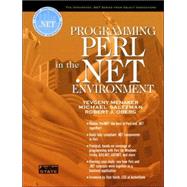
YEVGENY MENAKER is a developer, author, and Linux consultant. He has managed an Internet applications team focusing on new and advanced Internet technologies for the past three years.He has also worked in a bioinformatics research group developing Perl and Web applications.
MICHAEL SALTZMAN is the founder of /training/etc, a firm that specializes in Java, Perl, C/C++, Unix/Linux, Oracle, and XML training. He has been actively involved in writing courseware and teaching for over 25 years, and is author of Modern Perl Programming (Prentice Hall PTR).
DR. ROBERT J. OBERG is founder and President of Object Innovations, a leading developer of integrated courseware on .NET and other strategic software. He is editor of the Integrated .NET Series from Object Innovations and Prentice Hall PTR. Oberg's recent books include Introduction to C# Using .NET. He is also co-author of Application Development Using C# and .NET (Prentice Hall PTR).
I. INTRODUCTION TO .NET AND PERL.
1.NET Framework.II. PROGRAMMING WITH PERLNET.
The New copy of this book will include any supplemental materials advertised. Please check the title of the book to determine if it should include any access cards, study guides, lab manuals, CDs, etc.
The Used, Rental and eBook copies of this book are not guaranteed to include any supplemental materials. Typically, only the book itself is included. This is true even if the title states it includes any access cards, study guides, lab manuals, CDs, etc.